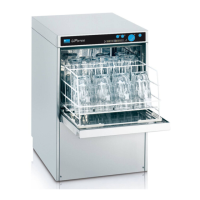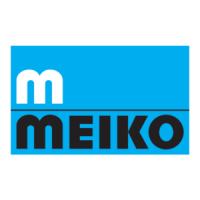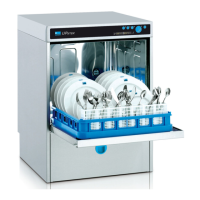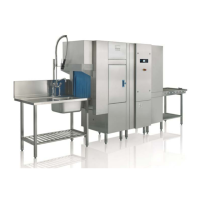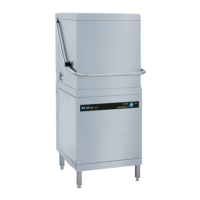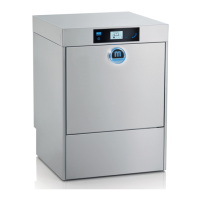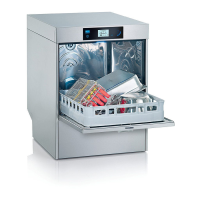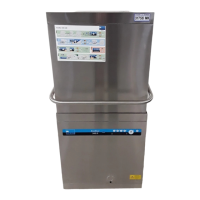How to reset factory settings parameter list on Meiko Dishwasher?
- Sscott09Aug 2, 2025
To reset the Meiko Dishwasher parameters to the factory settings, switch the power supply on and off within 5 minutes.
How to reset factory settings parameter list on Meiko Dishwasher?
To reset the Meiko Dishwasher parameters to the factory settings, switch the power supply on and off within 5 minutes.
What to do when Meiko Dishwasher shows maintenance required?
When the set operating hours or batch number has been reached on your Meiko Dishwasher, inform the service department and perform maintenance. You can also reset the maintenance counter.
What to do if Meiko UPster U 400 Dishwasher says incorrect password / no authorization?
If the Meiko Dishwasher displays 'Incorrect password / no authorization,' try entering the code again.
What to do if Meiko UPster U 400 regeneration is necessary?
The user must start the regeneration of the Meiko Dishwasher. Make sure to empty the tank and add salt.
What to do if the door of Meiko UPster U 400 is not closed?
If the door of your Meiko Dishwasher is not closed, check the S1 connection and change the microswitch. Also, check the microswitch adjustment and consider replacing a defective I/O circuit board.
Why is the emergency program active on my Meiko Dishwasher?
If the emergency program is active on your Meiko Dishwasher, and washing is restricted, check the system for boiler or tank heating issues and fresh water supply problems.
Instructions on where to store the operating manuals for easy access.
Contact details for MEIKO Maschinenbau GmbH & Co. KG and local branches.
Details MEIKO's exclusive authorization for service partners for commissioning and maintenance.
Information required for queries and ordering spare parts, including model and serial number.
Highlights the operator's responsibility to ensure safe operation and implementation of measures.
Covers dangers from improper use, moving parts, electrical hazards, and hot surfaces.
Specifies that electrical work must be performed by qualified electricians and outlines safety checks.
Instructions for checking delivery completeness, reporting damages, and handling appliances.
Guidelines for safe transport, handling, unpacking, and installation requirements.
Assumptions about staff training and customer-provided conditions for installation and operation.
Ensuring the installation area is frost-free to prevent damage to machine components.
Details on voltage, current, power supply cable, earthing, and connection terminals.
Specifies flow pressure, maximum pressure, protective measures against particles, and dirt trap.
Guidelines for waste water connection, including odour traps and grease traps.
Procedure for switching off the machine completely via the on-site power disconnection device.
Recommendations for suitable detergents and rinse aids and safety precautions.
Information on recycling and proper disposal of packing materials like wood, cardboard, and plastic.
Steps and safety precautions for initial setup and commissioning by qualified personnel.
Description of the control panel, keys, and display functions for operating the machine.
Steps to prepare the machine and load items correctly before starting a wash cycle.
Procedure for manually adding detergent to the wash water if automatic dosing is not available.
Explanation of how detergent and rinse aid are automatically dosed and recommendations for product types.
Fundamental principles for loading items into baskets to ensure effective washing and drying.
Steps to initiate the wash cycle, including pre-wash, loading, closing the door, and starting.
Instructions on how to safely remove cleaned items from the machine after the cycle completes.
Overview of the importance of regular care and maintenance for machine function and hygiene.
Instructions for refilling detergent in both incorporated and external containers.
Instructions for refilling rinse aid in both incorporated and external containers.
Procedure for cleaning the machine, including wash arms, nozzles, and tank components.
Safety warnings regarding hot tank elements and avoiding spraying electrical components.
Recommendations for cleaning stainless steel surfaces using appropriate cleaners and avoiding damage.
Procedure for de-scaling the machine, use of suitable agents, and when to contact a service engineer.
Information on the water softener's capacity, regeneration indicator, and potential usability issues.
Guidance on adjusting the water softening device based on actual water hardness during commissioning.
Graph illustrating the relationship between water hardness and softening capacity in liters.
Steps for regenerating the water softener, including salt filling and the regeneration process.
Overview of the machine's wash principle, disinfection methods, and dosing systems.
Explanation of the single wash and final rinse cycle, temperature control, and water jet circulation.
Details on how Thermolabel achieves hygiene values and potential effects on glass and decor.
Description of the optional automatic liquid detergent dosing unit and concentration guidelines.
Explanation of the automatic rinse aid dosing unit and how to achieve optimal results.
Specifies the workplace noise level, LPA £ 70 dB.
Reference to an attached technical sheet for detailed electrical and hydraulic data.
Reference to an attached technical sheet for dimensions and installation details.
Description of the control panel keys and their functions for programming and navigation.
Procedure for accessing different user levels and functions via access codes.
Accessing and navigating service parameters, including viewing/modifying, and ventilation functions.
Detailed steps for viewing and modifying parameters within the service level.
Procedure for actuating the rinse aid dosing pump to ventilate the inlet line.
Procedure for actuating the detergent dosing pump to ventilate the inlet line.
Function to reset the depletion display after changing partial demineralization cartridges.
Parameterization step for refilling the boiler with water after descaling before heater activation.
Accessing configuration parameters, input/output states, and setting outputs for testing.
Navigating and modifying parameters within the service level based on entered code.
Displaying the status of digital inputs and analogue input values like boiler temperature.
Viewing and modifying the status of machine outputs based on entered code.
Accessing and modifying parameters related to the dosing technology using specific codes.
Comprehensive list of machine parameters, their configuration, use, value range, and factory settings.
List mapping display inputs/outputs to their functions, statuses, and other related information.
Table detailing boiler temperature and wash time targets for various rinse programmes.
Explanation of information displays, how to clear them, and a table of common info codes.
List of error messages, their descriptions, possible causes, and troubleshooting steps.
Guidelines for observing maintenance intervals, component instructions, and safety precautions.
Ensuring initial tests are completed as per commissioning procedures after maintenance or repair.
Adhering to legal requirements for waste avoidance, recycling, and proper disposal of materials.
Information on the maintenance-free nature of dosing units and the impact of chemicals on wear parts.
Considerations when changing detergent or rinse aid products and rinsing hose lines.
Note that maintenance work should only be conducted by authorized MEIKO personnel.
Instructions on where to store the operating manuals for easy access.
Contact details for MEIKO Maschinenbau GmbH & Co. KG and local branches.
Details MEIKO's exclusive authorization for service partners for commissioning and maintenance.
Information required for queries and ordering spare parts, including model and serial number.
Highlights the operator's responsibility to ensure safe operation and implementation of measures.
Covers dangers from improper use, moving parts, electrical hazards, and hot surfaces.
Specifies that electrical work must be performed by qualified electricians and outlines safety checks.
Instructions for checking delivery completeness, reporting damages, and handling appliances.
Guidelines for safe transport, handling, unpacking, and installation requirements.
Assumptions about staff training and customer-provided conditions for installation and operation.
Ensuring the installation area is frost-free to prevent damage to machine components.
Details on voltage, current, power supply cable, earthing, and connection terminals.
Specifies flow pressure, maximum pressure, protective measures against particles, and dirt trap.
Guidelines for waste water connection, including odour traps and grease traps.
Procedure for switching off the machine completely via the on-site power disconnection device.
Recommendations for suitable detergents and rinse aids and safety precautions.
Information on recycling and proper disposal of packing materials like wood, cardboard, and plastic.
Steps and safety precautions for initial setup and commissioning by qualified personnel.
Description of the control panel, keys, and display functions for operating the machine.
Steps to prepare the machine and load items correctly before starting a wash cycle.
Procedure for manually adding detergent to the wash water if automatic dosing is not available.
Explanation of how detergent and rinse aid are automatically dosed and recommendations for product types.
Fundamental principles for loading items into baskets to ensure effective washing and drying.
Steps to initiate the wash cycle, including pre-wash, loading, closing the door, and starting.
Instructions on how to safely remove cleaned items from the machine after the cycle completes.
Overview of the importance of regular care and maintenance for machine function and hygiene.
Instructions for refilling detergent in both incorporated and external containers.
Instructions for refilling rinse aid in both incorporated and external containers.
Procedure for cleaning the machine, including wash arms, nozzles, and tank components.
Safety warnings regarding hot tank elements and avoiding spraying electrical components.
Recommendations for cleaning stainless steel surfaces using appropriate cleaners and avoiding damage.
Procedure for de-scaling the machine, use of suitable agents, and when to contact a service engineer.
Information on the water softener's capacity, regeneration indicator, and potential usability issues.
Guidance on adjusting the water softening device based on actual water hardness during commissioning.
Graph illustrating the relationship between water hardness and softening capacity in liters.
Steps for regenerating the water softener, including salt filling and the regeneration process.
Overview of the machine's wash principle, disinfection methods, and dosing systems.
Explanation of the single wash and final rinse cycle, temperature control, and water jet circulation.
Details on how Thermolabel achieves hygiene values and potential effects on glass and decor.
Description of the optional automatic liquid detergent dosing unit and concentration guidelines.
Explanation of the automatic rinse aid dosing unit and how to achieve optimal results.
Specifies the workplace noise level, LPA £ 70 dB.
Reference to an attached technical sheet for detailed electrical and hydraulic data.
Reference to an attached technical sheet for dimensions and installation details.
Description of the control panel keys and their functions for programming and navigation.
Procedure for accessing different user levels and functions via access codes.
Accessing and navigating service parameters, including viewing/modifying, and ventilation functions.
Detailed steps for viewing and modifying parameters within the service level.
Procedure for actuating the rinse aid dosing pump to ventilate the inlet line.
Procedure for actuating the detergent dosing pump to ventilate the inlet line.
Function to reset the depletion display after changing partial demineralization cartridges.
Parameterization step for refilling the boiler with water after descaling before heater activation.
Accessing configuration parameters, input/output states, and setting outputs for testing.
Navigating and modifying parameters within the service level based on entered code.
Displaying the status of digital inputs and analogue input values like boiler temperature.
Viewing and modifying the status of machine outputs based on entered code.
Accessing and modifying parameters related to the dosing technology using specific codes.
Comprehensive list of machine parameters, their configuration, use, value range, and factory settings.
List mapping display inputs/outputs to their functions, statuses, and other related information.
Table detailing boiler temperature and wash time targets for various rinse programmes.
Explanation of information displays, how to clear them, and a table of common info codes.
List of error messages, their descriptions, possible causes, and troubleshooting steps.
Guidelines for observing maintenance intervals, component instructions, and safety precautions.
Ensuring initial tests are completed as per commissioning procedures after maintenance or repair.
Adhering to legal requirements for waste avoidance, recycling, and proper disposal of materials.
Information on the maintenance-free nature of dosing units and the impact of chemicals on wear parts.
Considerations when changing detergent or rinse aid products and rinsing hose lines.
Note that maintenance work should only be conducted by authorized MEIKO personnel.
| Brand | Meiko |
|---|---|
| Model | UPster U 400 |
| Category | Dishwasher |
| Language | English |
